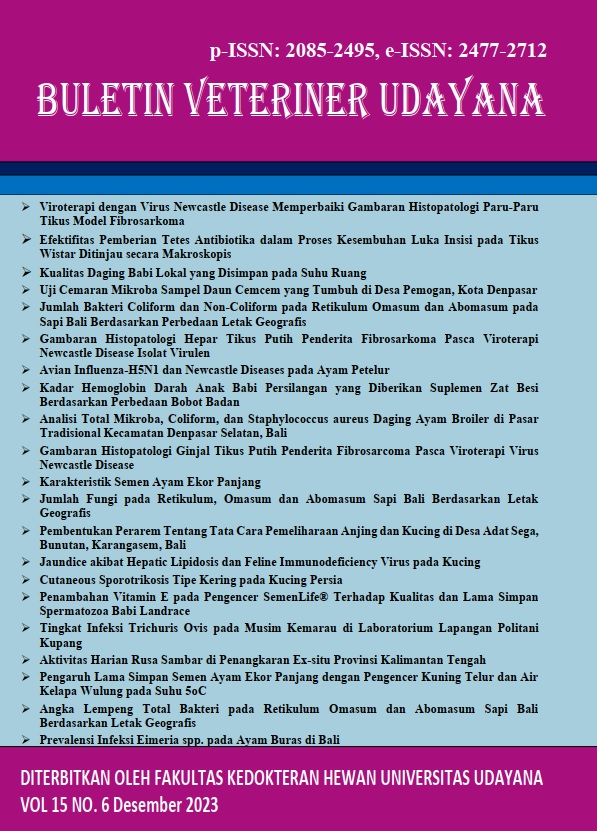GASTROINTESTINAL PARASITES ON ONE-HUMPED CAMELS IN BALI
Abstract
One-hump camel (Camelus dromedarius) is the most populous camel species in the world. Camels in Bali are used for tourist attractions, namely to be ridden by tourists. Gastrointestinal parasitic diseases. affect camel health which can reduce camel productivity and performance as well as predisposing to other infectious diseases. This study aims to identify the types of gastrointestinal parasites present in camels so that prevention and treatment can be carried out effectively. This study is an observational study with a cross-sectional study approach. The samples used were feces from all camels in Bali with a total of 10 camels kept at Bali Camel Adventure, Bali Camel Safari, and Akame Camel. Fresh feces of camels are stored in plastic pots using 10% formalin and 2% potassium bichromate separately. Fecal examination is carried out by three methods, namely the native method, sedimentation, and flotation. The gastrointestinal parasites found are identified based on morphology according to the literature. The data obtained are presented in a qualitative descriptive manner. The results of the study from 10 samples examined found (9/10) positive camels for nematode type gastrointestinal parasites with a prevalence reaching 90%. The gastrointestinal nematode parasites identified in one-hump camels in Bali are Capillaria spp., Strongyle type, Trichostrongylus spp., Strongyloides spp., and Trichuris spp. Given the high prevalence of gastrointestinal parasites in one-humped camels in Bali, improved husbandry management is recommended.
Downloads
References
Biu AA, Abbagana A. 2007. Prevalence of paramphistomes in camels slaughtered at Maiduguri, Nigeria. Nigerian J. Parasitol. 28(1): 44-46.
Bouragba M, Laatamna A, Cheddad FE, Baroudi D, Houali K, Hakem A. 2020. Gastrointestinal parasites of dromedary camel (Camelus dromedarius) in Algeria. Vet. World. 13(8): 1635.
Cirak VY, Senlik B, Gulegen E. 2011. Gastrointestinal parasites of camels (Camelus dromedarius) from turkey and efficacy of doramectin against trichostrongyles. J. Camel Pract. Res. 18(2): 283-285.
Demelash K, Alemu F, Niguse A, Feyera T. 2014. Prevalence of gastrointestinal parasites and efficacy of anthelmintics against nematodes in camels in Yabello District, Southern Ethiopia. Acta Parasitol. Glob. 5(3): 223-231.
Desta, A. H. 2019. Major helminth parasites of Camelus dromedarius in afar pastoral area of Ethiopia. Iraqi J. Vet. Sci. 33(1): 117-122.
Dubey JP, Schuster RK. 2018. A review of coccidiosis in Old World camels. Vet. Parasitol. 262: 75-83.
Hamed MA, Abdelgadir AE. 2021. Survey on Gastro-intestinal Parasites Infection in One Humped Camels (Camelus dromedarius) in Al-Butana area, River Nile State, Sudan. Diag. Pathol. Open 5: 2.
Hussein HA, Musse AH. 2022. Prevalence of Camel Gastrointestinal Helminths in Selected Districts of Fafan Zone, Eastern Ethiopia.
Ibrahim AM, Kadle AA, Yusuf AA. 2016. Gastro-intestinal parasites of camels (Camelus dromedarius) from Mogadishu, Somalia. Open J. Vet. Med. 6(07): 112.
Kusumamihardja S. 1995. Parasit dan Parasitosis pada Hewan Ternak dan Hewan Piaraan di Indonesia. Bogor: Pusat Antar Universitas Bioteknologi IPB.
Locklear TR, Videla R, Breuer RM, Mulon PY, Passmore M, Mochel JP, Smith JS. 2021. Presentation, clinical pathology abnormalities, and identification of gastrointestinal parasites in camels (Camelus bactrianus and Camelus dromedarius) presenting to Two North American Veterinary Teaching Hospitals. A retrospective study: 1980–2020. Front. Vet. Sci. 8: 651672.
Madani I, Apsari IAP, Oka IBM. 2021. Identifikasi dan Prevalensi Cacing Strongyle pada Sistem Pemeliharaan Sapi Bali Terintergrasi di Mengwi, Badung, Bali. Indon. Med. Vet. 10(2): 223-232.
Mahmuda A, Mohammed AA, Alayande MO, Habila YI, Lawal MD, Usman M, Suleiman N. 2014. Prevalence and distribution of gastrointestinal parasites of working camels in Sokoto metropolis. Vet. World. 7(3): 108.
Mohanapriya T, Saravanan S, Ramprabhu R. 2020. Concomitant infection of Trichuris globulosa and Trichostrongylus spp. in a dromedary camel.
Parsani HR, Singh V, Momin RR. 2008. Common parasitic Dis. of camel. Vet. World. 1(10): 317-318.
Radfar MH, Aminzadeh Gowhari M. 2013. Common gastrointestinal parasites of indigenous camels (Camelus dromedarius) with traditional husbandry management (free-ranging system) in central deserts of Iran. J. Parasitic Dis. 37(2): 225-230.
Rahmawati E, Apsari IAP, Dwinata IM. 2018. Prevalensi infeksi protozoa gastrointestinal pada sapi bali di lahan basah dan kering di Kabupaten Badung. Indon. Med. Vet. 7(4): 324-334.
Saidi R, Mimoune N, Chaibi R, Abdelouahed K, Khelef D, Kaidi R, Baazizi R. 2022. Camel gastrointestinal parasites in southern Algeria. Vet. Stanica. 53(3): 283-294.
San Diego Zoo Wildlife Alliance Library. 2021. Camels (extant/living species; Camelus spp.): Distribution & Habitat. https://ielc.libguides.com/sdzg/factsheets/extantcamels/distribution
Sazmand A, Joachim A. 2017. Parasitic Dis. of camels in Iran (1931–2017)–a literature review. Parasite. 24.
Schuster RK, Wernery U. 2004. On intestinal parasites in dromedaries (Camelus dromedarius) in the Dubai Emirate, UAE. Multidisciplinarity Parasites, Vectors and Parasitic Dis. 2: 511-514.
Taylor MA, Coop RL, Wall RL. 2007. Veterinary Parasitology. Blackwell Publishing.
Taylor MA, Coop RL, Wall RL. 2016. Veterinary parasitology. John Wiley & Sons.
Umardhani T. 2011. Cacing Parasitik Pada Unta Punuk Satu (Camelus dromedarius) di Taman Rekreasi Margasatwa Serulingmas Banjarnegara Jawa Tengah. Skripsi. Bogor: IPB.
Wario S, Wubishet Z, Alemayehu M. 2020. Prevalence and associated risk factors of major prevalent gastrointestinal nematodes in camels of Borena Zone, Southern Ethiopia. J. Vet. Med. Res., 7(1), 1179.
Wernery U, Kaaden OR. 2002. Infectious Dis. in camelids. Georg Thieme Verlag.
Zajac AM, Conboy GA. 2012. Fecal examination for the diagnosis of parasitism. Vet. Clin. Parasitol. 8: 72-73.





